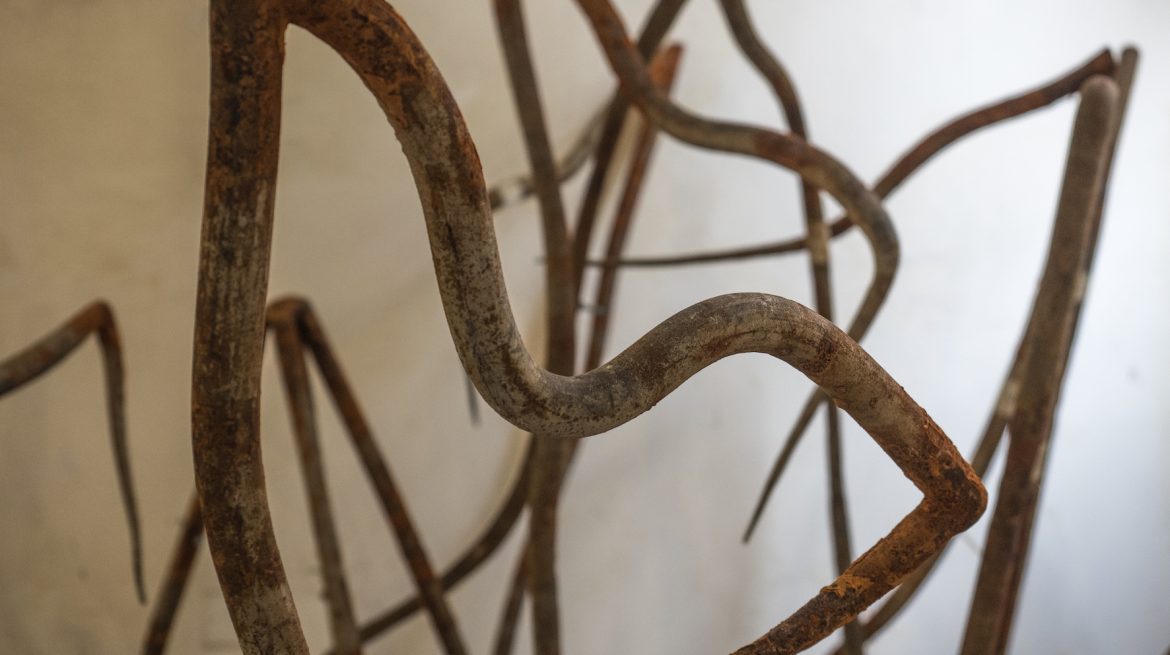Dominique White: Deadweight at Whitechapel Gallery

The biannually awarded Max Mara Prize for women, established in 2005 and collaboratively organised by the Whitechapel Gallery, Max Mara and Collezione Maramotti, is the sole visual prize for UK-based women-identifying artists. The Whitechapel now plays host to the most recent winner, Dominique White. Deadweight, the artist’s debut exhibition at a major British institution, takes its name from the measuring of the weight of a ship’s cargo. This new body of work was produced during White’s six-month award residency in Italy.
Stepping into a darkened gallery here, the visitor finds four hulking structures emerging from the gloom. Nautical history has long been a recurring theme in the London-born artist’s practice. These unwieldy sculptures resemble the twisted remains of shipwrecks on the ocean floor or grotesque sea monsters caught in the glare of a submarine. Whilst in Italy, White corroded her work by submerging it in the sea and the resulting deterioration along with the tattered linen, wood and rope combine to conjure up a haunting maritime graveyard. The presence of iron on board sailing ships from the past holds sinister overtones for the artist, standing as “one of the signifiers that Blackness has been present”. Rusty iron chains featured in Split Obliteration (2024) eerily recall the horrors of the slave trade.
Deadweight sees Dominique White exploring themes of Black Subjectivity, the African Diaspora, Afro-futurism and Hydrarchy. The latter term is a 17th-century word that has been associated with the Essex and Marseille-based artist’s work, describing the concept of gaining power and wealth by means of water. White turns that idea on its head by exploring the notion that those accorded limited value – namely pirates and slaves within the ship can topple the ship’s hierarchy. Over her six-month residency, White was much influenced by the writings of the anti-colonial academic Katherine McKittrick on the transatlantic slave trade.
A notably stylish film on view at the Whitechapel, produced by Max Mara, features the artist discussing the impact of her extensive research over six months in Italy, in the historical harbour of Genoa, the birthplace she mentions of Cristopher Columbus. Also visiting Agone, Palermo, Milan and Todi, White explored archives, delved into Mediterranean naval history and worked closely with academics such as Giovanna Fiume, a specialist in historical migration. The two of them discussed historic routes and piracy and how that “shaped the idea of a ship and movement throughout the world”. Fiume appears in the film along with other mentors. One also learns that whilst in Italy, White spent time in foundry factories and learning traditional and contemporary metalworking skills.
White, a professed breaker of artistic rules, wants Deadweight to “be about work falling apart, dilapidated, decaying but as a means of inspiring the idea of rebellion in people”. These fragile yet resilient sculptures, or “beacons” as she dubs them, summon shipwrecks of migrants and slaves, their watery grave evoked by the Whitechapel’s dark setting. At the same time, the artist’s work envisages the oceanic world as an emancipatory space for an Afro future free from colonialist influence.
James White
Photo: Zouhair Bellahmar
Dominique White: Deadweight is at from 2nd July until 15th September 2024. For further information or to book visit the exhibition’s website here.


















Facebook
Twitter
Instagram
YouTube
RSS